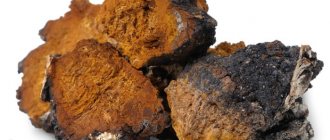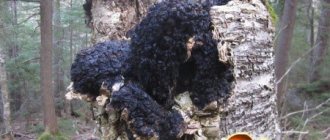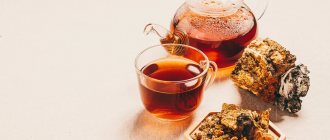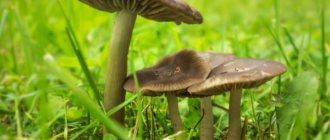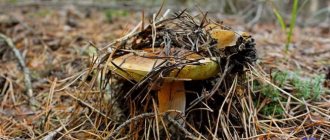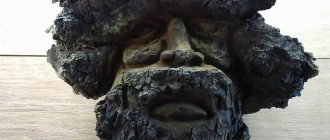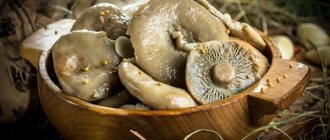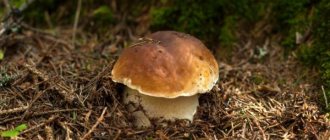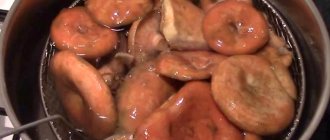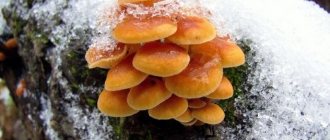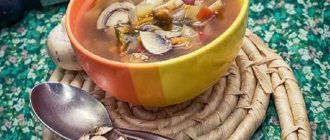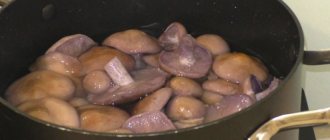Ecology of consumption. Before brewing healthy tea, let's get to know a little about what chaga mushroom is, where it grows, and how to prepare it.
Chaga tea is consumed instead of regular tea or coffee, and prepared chaga decoctions and tinctures are used as medicine to improve immunity, as a result of which the body is cured of many diseases. Such medicinal use of chaga should be carried out under the supervision of a doctor and as an additional remedy along with the main treatment.
Before brewing healthy tea, let's get to know a little about what chaga mushroom is, where it grows, how to prepare it and for what purposes it is used. If you already know this, you can skip this part of the article and go straight to recipes for making teas and infusions.
What is birch chaga, how and why it is formed
Chaga or black birch mushroom is a sterile form of the parasitic polypore fungus found on birch trees. Sometimes it settles on other growing trees such as maple, alder, elm, rowan, beech.
If the bark is damaged, the tree can become infected with spores of the fungus Inonotus obliquus, which grow deep into the trunk. In this place, a growth forms - chaga, in which substances secreted by the tree accumulate to combat the uninvited guest. These substances are immunostimulants that have a therapeutic effect on a living organism.
Chaga grows on a birch tree like a cancerous tumor and the tree, fighting it, tries to suppress its growth, so the growth contains substances that can restrain the ongoing pathological processes.
Chaga tea
To brew chaga tea, only wild chaga is suitable. The finer the powder into which it is ground, the more active ingredients the chaga will release into the tea. Chaga tea is usually boiled, but this is not necessary. You can cook it at temperatures below 100 °C, without bringing it to a boil, but simply increasing the heating time. The longer the cooking time, the more “interesting” things appear in the broth, giving it an attractive taste. For example, after a few hours the decoction will contain not only melanin and polysaccharides, but also vanilla acid contained in the chaga, which will give the tea a syrupy taste with notes of vanilla.
Stainless steel or glass teapots are best for brewing. The kettle is filled with clean cold water, to which you add ground chaga and, if desired, other mushrooms and/or herbs. Before turning on the kettle or putting it on the fire, give the water a few minutes to soak the mushroom and herb powder (alternatively, if you are adding herbs, it is best to pre-soak them before steeping them in room temperature water for 5-30 minutes). If you only have chaga in the kettle, you can safely boil it for about 20 minutes (but you can also use a water bath at low boil for up to an hour, it will be tastier). If it is a mixture of chaga with herbs, the correct method would be to slowly (over half an hour to an hour) raise the temperature to 70-80 °C. This will allow the active substances of herbs to be extracted most completely and carefully. Strain the finished drink through a strainer. To taste, you can add nut milk, coconut milk, cream, honey, and spices. Brewed tea in a container with a lid is stored in the refrigerator for up to a week.
An interesting and very simple way to maximize the extraction of active substances from chaga is to freeze chaga tea . After cooling, the finished decoction should be placed in the freezer along with pieces of chaga . When frozen, those chaga cells that remain intact after crushing and boiling burst. Once removed from the freezer and reheated, they will become a decoction.
The chemical composition has not been sufficiently studied
Chaga is not well studied chemically. It consists of approximately 12% ash, contains a lot of manganese, potassium and calcium, as well as acids (acetic, formic, oxalic, butyric, vanillic), polysaccharides, lignin, fiber, free phenols, etc.
The presence of pterins in chaga determines its antitumor effect, incl. and for malignant tumors.
Chaga in medicine: research on medicinal properties
The study of chaga as a medicine for medical use and the study of its effects on the human body began in the 60s of the last century.
The Leningrad Medical Institute conducted a number of studies that showed that chaga normalizes redox processes, strengthens, tones and restores the nervous system, eliminates exacerbations and normalizes the functions of the stomach and duodenum. X-ray studies have confirmed the positive effects of chaga on gastrointestinal diseases. When consuming the mushroom infusion, venous and blood pressure decreased and the pulse slowed down. Chaga decoction could reduce blood sugar from 15% to 30%.
Research conducted in Kyiv has shown that when using chaga, the metabolism of brain tissue is activated, i.e. The activity of the cerebral cortex increases. Chaga has anti-inflammatory properties of a general and local nature. In these experiments, it was found that chaga helps slow the growth of certain tumors and reduces the effects of radiation exposure.
In Japan, studies were carried out on the medicinal properties of chaga, as a result of which they recorded the high antiviral and immunomodulatory properties of chaga preparations.
At the University of Haifa (Israel), the anticancer activity of chaga preparations was studied and confirmed.
So, chaga is a unique mushroom that is saturated with a huge amount of useful substances and has a wide range of medicinal effects.
Beneficial properties of birch chaga
It’s hard to believe that the chaga mushroom, growing in almost any birch grove, has a huge number of beneficial properties, and it has unique medicinal indications. They have been tested not only for many years in folk medicine, but many of them are clinically confirmed.
The main beneficial properties of birch chaga:
- has antimicrobial, diuretic and antispasmodic effects;
- normalizes the microflora of the gastrointestinal tract;
- helps with the healing of duodenal and stomach ulcers;
- normalizes the functioning of the respiratory and heart organs;
- equalizes blood pressure and pulse rhythm;
- has a positive effect on the nervous system;
- accelerates metabolism, incl. in brain tissue;
- increases immunity and resistance to infections;
- has anti-inflammatory and analgesic internal and external effects;
- stimulates blood formation;
- helps in the treatment of malignant tumors;
- reduces the amount of sugar in the blood.
Long-boiled chaga, or universal health drink
Preparing such a universal health drink is simple, but quite time-consuming. Meanwhile, the drink is truly universal, since it provides support for almost any disease, while at the same time being a preventive measure for most of them, and has a tonic effect. The most important thing here is regular, preferably daily, drinking of the drink in the morning. It will then support and regulate the immune system, combat digestive problems, stimulate the formation of cancer-fighting cells and give you glowing skin, fuller hair and sharper vision.
The taste of chaga tea is not very similar to tea itself, but it also cannot be called mushroom in taste. Rather, it is closer to coffee, with obvious woody notes. You can customize the taste of the drink as you like - this will not affect its properties. Add tea, cocoa or coffee, spices, honey, milk (including coconut), fresh berries or fruits depending on your mood or season.
For 1 liter of water use 1 tablespoon of ground chaga. Fill a saucepan with water, add chaga and bring to a boil over high heat, then simmer for 12 to 24 hours, stirring regularly. The longer you brew chaga, the more you shift from just a drink to a medicinal form. If you decide to add any spices or herbal flavors, do this about half an hour before the end of cooking. At the end of the process, chaga tea needs to be strained and then can be poured into cups, adding milk, honey and other ingredients to your taste. Chaga tea stores well in the refrigerator; you can pour it into a hermetically sealed plastic or glass container and store for up to 5 days, pouring and heating the required portions.
How to collect
In general, growths from trees can be cut off at any time of the year, but the maximum concentration of useful substances is observed in them in autumn and spring. It is very important to collect raw materials only from still living birches; if the plant is already dead, then there will be very little benefit from such a product.
Chaga is removed from the plant using an ax or a fairly thick knife. This is not as easy to do as it seems at first glance, since the growth is firmly attached to the trunk.
When collecting medicinal raw materials, the following nuances should be taken into account:
- the highest quality and most useful are the growths on trees that grow in groves;
- the higher the birch mushroom is located on the trunk, the better;
- the product should not easily crumble in your hands and be completely dark;
- the most useful specimens are those whose length does not exceed 100 cm.
When collecting birch growths, it is very important not to confuse them with tinder fungi. To do this, it should be taken into account that they are lighter in color and have the appearance of a hoof. The chaga is firmly attached to the trunk; without an ax or knife, it does not come off, compared to the tinder fungus, which is separated from the tree without much effort.
Short boiled chaga
According to some reports, briefly but vigorously boiling chaga releases additional ingredients to fight or prevent cancer, that is, it provides some release of fat-soluble triterpenoids into the decoction.
Pour 1 liter of coarsely crushed chaga (pieces about 1 cm) into a saucepan with 10 liters of water. Cover the pan with a lid, bring to a boil and cook over high heat for 2-3 hours. The finished broth must be filtered and can be drunk hot, warm or at room temperature. Do not throw away the chaga pieces; they can be boiled 2-3 more times.
Collection, processing and storage of birch mushroom
Chaga is collected year-round, but the preferred season for harvesting this natural product is late autumn and early spring. To collect, use a knife or an ax to cut the mushroom at the base, separating the less useful yellowish part that is softer in density. A dried mushroom becomes almost stone-like, so it is necessary to cut it into small pieces immediately after collection, then processing will be less difficult.
To store the product for a long time, you need to cut it into pieces and dry it well in the open air or in an oven at a temperature of up to 60°. After drying, the mushroom should have a moisture content of no more than 12% and 1/5 of extractive substances of the total volume. The dried product should be stored in a dry place in a container with a tight lid, protected from moisture.
The preferred season for collecting chaga is late autumn or early spring.
Chaga double extract
So, if you want to get the maximum benefits from chaga at home, use the double extraction method. In principle, this method works not only with chaga, but also with any other dried medicinal mushrooms. And yet, more often it is used for those of them that are difficult to grind into powder at home due to increased hardness or fibrousness (chaga, multi-colored, flat and ordinary tinder fungi, reishi, etc.).
Double extraction implies two successive stages of processing, which are necessary in order to extract the entire complex of active substances from the mushroom, not only to the maximum, but also in optimal proportions. At the first stage, chaga is soaked in pure or slightly diluted alcohol (at least 80%) for 20 to 40 days (try to get alcohol; good double-distilled moonshine will also work). The smaller the pieces into which the chaga is chopped, and the higher the alcohol strength, the less time you can infuse. We know that at a strength above 60-65%, alcohol begins to work as a preservative for many organic substances (which is why strong alcohol tinctures are not always “full”), but for fat- and alcohol-soluble components, alcohol is an ideal “extractor”.
The most valuable alcohol-extractable components of chaga are triterpenoids (anti-inflammatory activity), sterols (antiviral activity), ergothioneines (antioxidants). All these substances are inaccessible for digestion: hot water has practically no effect on them. After receiving the alcohol tincture, the pieces of chaga need to be removed from it, rinsed with cold water, transferred to a hot place and boiled. This will give us the opportunity to extract water-soluble polysaccharides - the second main group of medicinal components of the mushroom. Don’t be afraid of boiling - the polysaccharide complexes of mushrooms are not destroyed at 100 ° C, but their extraction is much more efficient: remember - sugar dissolves in hot water much faster than in cold water, but remains sweet sugar. Why, you ask, extract substances from chaga sequentially, if part of the mushroom can be put into alcohol, and the other part into boiling water? The fact is that after treatment with alcohol and removal of fat-soluble components, water-soluble ones are pulled out most completely with hot water, since the pieces of fruiting bodies are already “prepared” and somewhat loosened with alcohol. The boiling time depends on the size of the chaga pieces (the larger the longer) and takes from 12 hours to a day . You can cook in any container; the water temperature during cooking is 80-100° C.
For both alcohol and water extracts to be most effective, the chaga pieces should take up one-third to one-half of the volume filled with alcohol or water. After receiving the tincture and decoction, you can use them as you wish - individually and in a mixture, in pure form or adding them in varying proportions to other foods or drinks. The optimal ratio for mixing alcohol and water extracts is 1:2. A tablespoon of this “potion” per day will have the maximum physiological effect.
If you don’t want to bother with all of the above, but still want a double extract, go to any pharmacy and buy two drugs: befungin and chaga tincture. Befungin is an aqueous extract, chaga tincture is an alcohol extract. Mix them in a 1:2 ratio, and you have a more or less acceptable double extract. Of course, the alcoholic part of the extract in this case was obtained at an alcohol strength lower than recommended (70, not 80%), and you won’t check the quality of the raw materials either, but overall everything should be very good. On a note
If you are an opponent of strong alcohol in moral and aesthetic terms, or alcohol is not indicated for you for some medical reasons, then after infusing and removing the chaga, you can evaporate it by placing the tincture on medium heat. Moreover, alcohol is not the only possible solvent, and instead you can use other more or less effective extractors for triterpenoids - glycerin or vinegar. Just keep in mind that glycerin will subsequently no longer mix normally with the water infusion if you want to prepare a mixture of triterpenoids and polysaccharides.
Beneficial features
The scientific name of chaga is “Tinder fungus” or “Inonotus oblique”. It is a parasitic fungus and grows mainly on birch trees. This is where it got its common popular name – “Birch Mushroom”.
Infection of a tree occurs with spores through damage in the bark, after which a growth forms on the trunk. After 15–30 years, it can reach a circumference of 10 to 40 cm, which inevitably leads to the death of the tree. The composition of chaga has been poorly studied by scientists. It is known that the composition includes:
- pigments;
- agaricic acid;
- resins;
- manganese;
- micro- and macroelements.
The substances contained in the mushroom normalize the acidity of the stomach and have anti-inflammatory and antiseptic effects. They have a beneficial effect on the functioning of the kidneys and the genitourinary system as a whole, promote the removal of toxins and cell regeneration.
What diseases does it help with?
Folk remedies and pharmaceutical products made from chaga are recommended for:
- gastritis;
- stomach ulcer;
- decreased immunity;
- cold;
- oncology;
- toxic poisoning;
- to reduce side effects during radiotherapy and chemotherapy;
- atherosclerosis;
- prostatitis.
Chaga is also used for autoimmune diseases, for faster healing of wounds, pain relief and relieving symptoms of chronic fatigue.
Alcoholic extract of chaga
As I wrote above, for better extraction of alcohol- and fat-soluble compounds of chaga (lanostane, triterpenoids, etc.), alcohol with a strength of 80% is required. Add 3-4 tablespoons of chaga powder per 0.5 liter of alcohol. The tincture should be kept for a month in a dark place, periodically removing and shaking the bottle. After a month, filter the tincture and dilute it to a working strength that suits you (30-50%). Those who use the drip method can pour the tincture into bottles with dispenser caps. You can store it in any dark place, not necessarily in the refrigerator.
Contraindications
It should be remembered that, like any other herbal remedy, chaga-based decoctions and infusions have their contraindications. For example, they should never be combined with antibiotics. Another important contraindication is simultaneous use with glucose.
In some people, this natural remedy can cause an allergic reaction, so before starting a course of treatment, it is recommended to do an allergy test - drink literally a teaspoon of the prepared product and monitor the reaction.
When treating with birch fungus preparations, a dairy-vegetable diet is indicated with the exception of canned food, spicy seasonings, and animal fats. The use of penicillin and intravenous dextrose are contraindicated.
Children under 18 years of age should not be treated with this natural remedy. You should also consult your doctor before starting therapy.
Chaga oil extract
This is a fairly new trend that requires further research;
There are no real scientific studies in this regard yet. It arose as a home alternative to industrial CO2 extractors for extracting the fat-soluble components of medicinal mushrooms. Chaga powder is filled with some raw vegetable oil or a mixture of oils. David Wolf, a famous American researcher and manufacturer of organic bioactive products, recommends the following composition of the mixture (100 ml in total): coconut oil - 30%, cocoa butter - 30%, olive oil - 30%, hemp oil - 10%. To these 100 ml add 25-50 g of chaga powder. The mixture is heated until a homogeneous substance is formed in a water bath. The oil extract can be used to season salads, hot teas, homemade chocolate, etc. Since chaga oil certainly has an affinity for the skin, you can try using it as a component of creams or simply for massaging.
Myth fifth. After removal of the prostate adenoma, you can forget about intimate life.
And that's not true. After surgery (open and sparing), in 90% of patients, sexual function is restored in full. Problems can only arise with conception, since 30% of those who have undergone surgery to remove an adenoma develop so-called retrograde ejaculation, when ejaculation occurs not outward, but into the bladder. But this problem can also be fixed. If a man dreams of an heir, another medical invention comes to the rescue - in vitro fertilization. Only in this case, the process of artificial conception is preceded by a rather complex procedure - special centrifugation of urine, which allows separating sperm. And only then they take it to the woman. Of course, this is not very pleasant. But men do not complain: living with a constant eye on the toilet or with a tube in the bladder is much worse. Prepared by Tatiana GURYANOVA AiF-Health dated July 30, 2009
